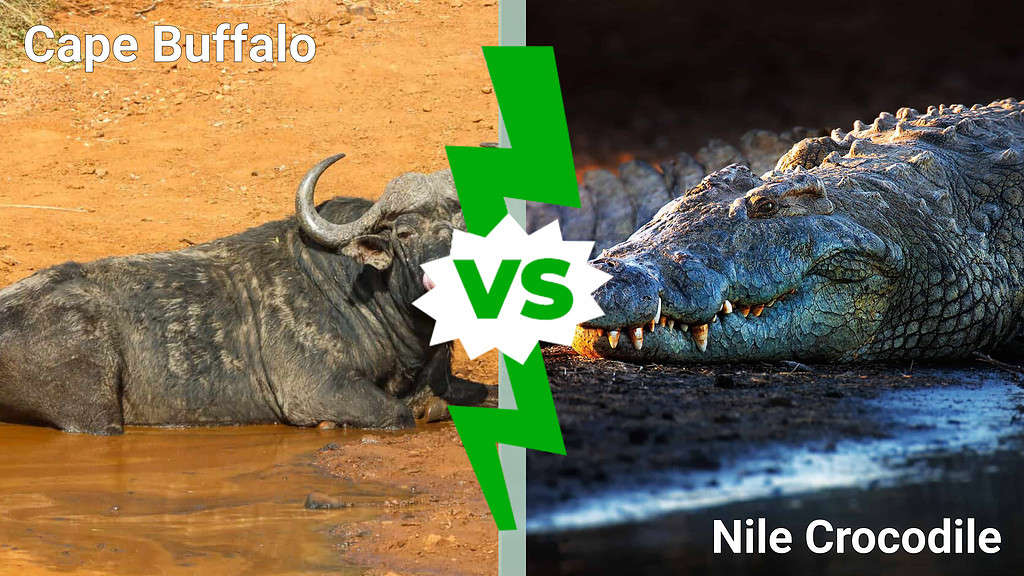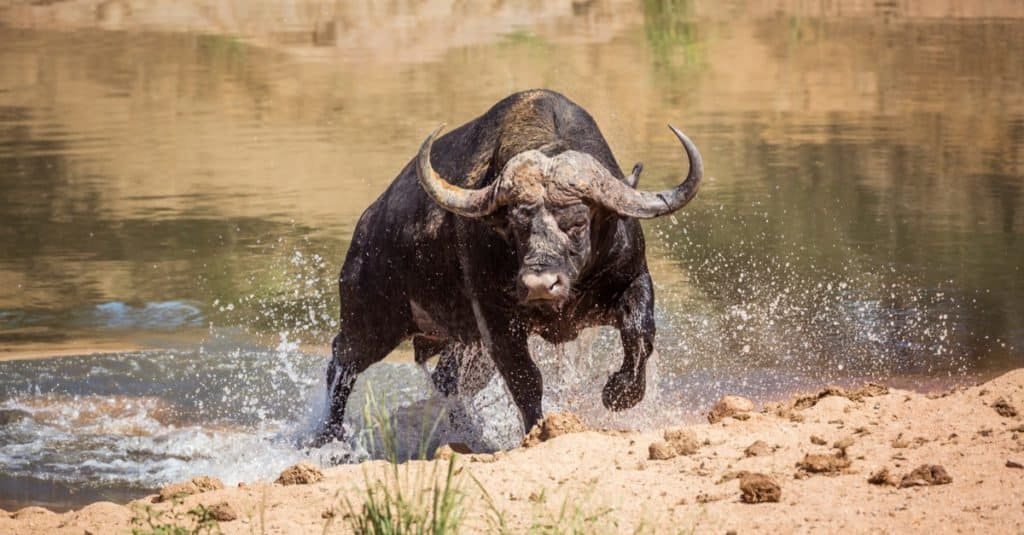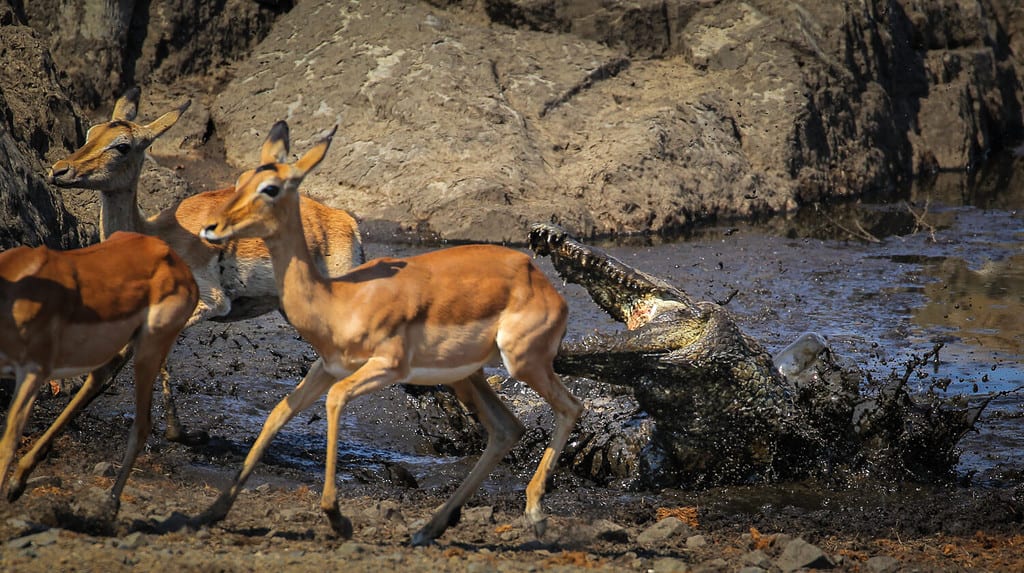Africa is home to a wide assortment of wildlife. Cape buffalo is one species of large mammal that lives in herds, and they’re preyed upon by various creatures, including lions. Nile crocodiles are some of the deadliest animals on the continent, killing hundreds of people each year along with many animals. Discover which creature would make it out alive in a cape buffalo vs. Nile crocodile bout! See why figuring out the winner is not that simple.
Comparing a Cape Buffalo and a Nile Crocodile

| Cape Buffalo | Nile Crocodile | |
|---|---|---|
| Size | Weight: 600 to 2,000 pounds Height: 4 to 5.8 feet Length: 6 to 8 feet | Weight: 500 to 910 pounds, sometimes over 1,300 pounds Length: 9 to 15 feet |
| Speed | – 22 to 35 mph | – 19 to 22 mph |
| Defenses | – Large body makes attacking buffalo difficult – Lives in a herd, offering some protection from predators – Their speed can help them escape from some attackers | – Their coloration makes it easy to hide in bodies of water – Can stay mostly submerged in water for 30 minutes to 2 hours – Tough skin reinforced with scutes on top – Ability to reach high speeds in water where most other animals cannot chase after them |
| Offensive Capabilities | – Long, powerful legs allow them to kick their foes – Can use their long horns to gore enemies | – Has a bite force of 3,000 psi, allowing them to puncture deep into prey and break bones – Uses cone-shaped teeth reaching 3 to 4 inches in length – Will use a “death roll” to amputate limbs or to drag, disorient, and drown their prey |
| Predatory Behavior | – No predatory behavior since it is an herbivore | – Ambush predator that attacks from below the waterline – Does not always pursue prey if it misses its initial assault |
What Are 2 Key Differences Between a Cape Buffalo and a Nile Crocodile?

Cape buffalo, despite weighing as much as a ton, can race up to 40 mph, jump up to 6 feet vertically, and quickly pivot to combat predators.
©PACO COMO/Shutterstock.com
The major differences between a cape buffalo and a Nile crocodile are their morphology and overall size. Alligators are lengthy reptiles with elongated snouts and long tails, but they’re low to the ground. They spend much of their lives in the water. Meanwhile, cape buffaloes are land-dwelling animals with long legs, thick bodies, and large horns in some members of the species.
Cape buffaloes are heavier than Nile crocodiles, weighing up to 2,000 pounds while most of the crocodiles weigh from 500 to 910 pounds. Meanwhile, cape buffaloes are about 8 feet long compared to the Nile crocodile which measures between 9 and 15 feet in length.
These pronounced differences in body type and size will have a major impact on the outcome of this fight. Yet, we need more information to find out which animal is most likely to survive this bout.
What Are the Key Factors in a Fight Between a Cape Buffalo and a Nile Crocodile?

Nile crocodiles are ambush predators.
©JMx Images/Shutterstock.com
The key factors in the fight between a cape buffalo and a Nile crocodile are the same as most other animal fights. The creatures’ size, speed, defenses, offensive powers, and predatory habits will all come into play. The following section will evaluate these animals in each of these respects, find out which one has the advantage in them, and use the collected data to name a winner of the bout. Let’s get started!
Cape Buffalo vs. Nile Crocodile: Size
The cape buffalo is larger than the Nile crocodile. The average cape buffalo weighs between 600 and 2,000 pounds, stands about 4 to 5.8 feet tall, and measures between 6 and 8 feet long. Meanwhile, the Nile crocodile weighs anywhere between 500 and 910 pounds, but they can also weigh as much as 1,300 pounds in rare cases. These animals are not very tall, but they can grow between 9 and 15 feet long.
The average cape buffalo has the size advantage.
Cape Buffalo vs. Nile Crocodile: Speed
Cape buffalo are quite speedy given their size. The average cape buffalo can run at speeds between 22 and 35 miles per hour. Meanwhile, the Nile crocodiles can reach speeds between 15 and 22 miles per hour on land, but only for a short distance. They can also reach speeds of 22 miles per hour in the water.
Cape buffalo have the speed advantage in this fight.
Cape Buffalo vs. Nile Crocodile: Defenses
The cape buffalo relies on its size to stay safe in a one-on-one fight. These animals have long legs and thick bodies, so they can take a fair amount of punishment from enemies. Also, the cape buffaloes tend to stick in a herd, providing them additional protection from individual predators.
Nile crocodiles have the benefit of their unique habitat, mostly staying in the water where they’re hard to see. Even if some animal was trying to attack them, the crocodile can quickly swim away. Also, the crocodile has thick skin with scutes on the top.
The Nile crocodile has the advantage in defense.
Cape Buffalo vs. Nile Crocodile: Offensive Capabilities
The cape buffalo does not have much in the way of offensive capabilities. They can kick, trample attackers, and use their long, curved horns to gore their enemies. However, they do not have many ways of attacking outside of those methods.
Meanwhile, the Nile crocodile is loaded for attack. They have an elongated mouth with between 60 and 64 teeth. They can bring these sharp, conical teeth down on their prey with 3,000 psi. From there, they will drag their prey into the water and then use a so-called death roll to amputate limbs and tear chunks out of them. That action will also disorient and potentially drown their prey.
The Nile crocodile has the advantage in offensive capabilities.
Cape Buffalo vs. Nile Crocodile: Predatory Behavior
The cape buffalo does not have any predatory behaviors since it is an herbivore. However, the Nile crocodile is an apex predator that uses ambush predator tactics to take down its prey. These reptiles wait below the waterline for their prey to come close. Then, they burst forth and take them down into the depths. If they miss, though, they’ll often give up on the pursuit.
Who Would Win in a Fight Between a Cape Buffalo and a Nile Crocodile?

The Nile crocodile will win this battle.
©diegooscar01/Shutterstock.com
A Nile crocodile would win in a fight against a cape buffalo. This statement comes with several caveats. First off, the crocodile would only kill the cape buffalo in a specific situation. The cape buffalo would have to be going to a body of water for a drink. The crocodile would ambush the mammal, grabbing it and pulling it into the water. From there, the crocodile would have to drown or otherwise overwhelm the creature to kill it.
The Nile crocodile can also win this fight by making the buffalo flee. So, if the crocodile misses its initial attack, the buffalo will live, but it would technically lose the fight by staying out of range. It would want nothing to do with the monstrous reptile.
In the last case, the crocodile could attack the buffalo, go too far onto the land, and feel the wrath of the large mammal. Some video evidence exists of cape buffaloes goring and tossing Nile crocodiles into the air, severely injuring them. In that case, the mammal could win. However, in most cases, the crocodile will either snatch the cape buffalo into the water or cause it to flee, leaving the crocodile the victor, even if it’s a technical win. In a death match on land, though, a cape buffalo could win a fight against a crocodile, especially in a prolonged fight.
The photo featured at the top of this post is © Hannes Thirion/Shutterstock.com
Thank you for reading! Have some feedback for us? Contact the AZ Animals editorial team.







